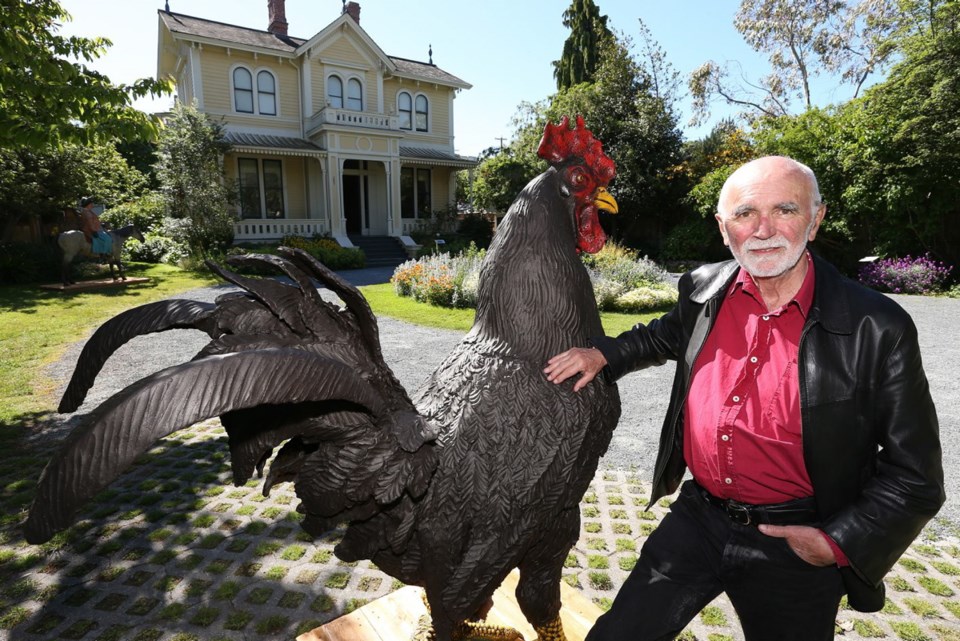As you approach Emily Carr House, the first thing you notice is the life-sized statue of Emily Carr riding a horse. It’s the young Emily, and she’s on the driveway, just to the left of the front door. What could be more natural? It looks passably like her. She’s young, determined, and she’s not riding side-saddle.
Joe Fafard recently made this beautiful bronze of Emily at his home in Regina. More correctly, he modelled it, and with his direction and collaboration, his numerous employees cast it in the foundry which Fafard built to create his own sculptures. He made this life-sized statue during the past three months. “It was really a push,” Fafard said. Almost everything on show — and it is extensive — has been created for this 10-day event at Carr House, 207 Government St.
Fafard, born in 1942 in Ste. Marthe, Sask., is probably Canada’s best-loved sculptor. He’s been a member of the Order of Canada since 1981. To prepare for our interview, I read his fascinating autobiography, published by Canada’s National Gallery (and the Norman Mackenzie Art Gallery in Regina) in 2007, in which he lucidly explains the wellsprings of his down-to-earth artistry.
Illustrated are Fafard’s statue of former prime minister John Diefenbaker giving a speech while standing on a kitchen chair (in bronze, patinated and painted); portrait busts of Vincent Van Gogh (in earthenware with acrylic paint) and many horses, cattle and buffalo (drawn in charcoal, cast in bronze, and later created in laser-cut steel). His half-size models of Cree and Métis people are particularly insightful.
At Carr House you can leave Emily (and Fafard’s giant rooster) outside and proceed by a short walk through a lovely garden. Once inside, you are enfolded in the richly resonant rooms of this 1862 residence.
What a delight to find, on the dining-room table, Fafard’s little colt: anatomically correct, conscious of its character and about the size of a collie dog. In the hall nearby, a small horse stands in a pool of light. There are terriers on the mantlepiece and cattle graze on the mahogany sideboard. A sow and her piglets enjoy the sunshine in the bay window of the parlour.
The rooms at Carr House retain their period character but for this show have been stripped of all extra ornament. Meeting dozens of enchanting sculptures in these intimate rooms is a bit like coming upon a string quartet — it’s chamber music, accorded a special performance. For his own reasons, Fafard, a great Canadian artist in the prime of his career, has this year created a new body of work specifically for Carr House. Feast your eyes. Something special is going on here.
Don’t imagine this artist is making caricatures. These are farm animals and, through his Saskatchewan life, Fafard has entered a respectful partnership with these horses, cows and dogs. In his workmanlike way he is primarily concerned with their form, a sort of structural architecture of the domesticated animal.
To honour Carr, Fafard created his versions of the animals she knew. Previous to this show, he already had a major Carr grouping to his credit. In 2005, Fafard was commissioned by the Heffel Auction house to create a bronze ensemble — Emily, her monkey Woo, her dog Billie and a horse. Now, in Victoria, he presents the individual elements of this ensemble, each a generous table-top size. Particularly striking is his unsentimental statue of Emily gazing at the distant mountains on one of her rare trips to the Interior.
Beyond the sort of animals that make up this show, the artist is widely admired for his portrait sculptures of Canadian statesmen — Diefenbaker, Chrétien, Trudeau — and artists — Renoir, Cézanne and Van Gogh. These are much more than simple mannequins, and his work can be engaged with on many levels.
Fafard, like William Kurelek and David Blackwood, is a narrative artist telling the stories of our unique culture from his point of view. While celebrated in the highest galleries in the land, here is an art that is immediately accessible to all — the casual browser, the lover of animals, and the connoisseur who stops to consider Fafard’s place in Canadian history.
This is a truly special exhibition, and Carr House has never looked better.
Joe Fafard: Emily’s Menagerie, at Emily Carr House, 207 Government St., until June 16.
